Myths vs Facts
There are many misconceptions about human trafficking. Click here, to find out the facts to some common myths.
Human Trafficking Basics
What are the types of Trafficking?
How do Traffickers recruit their victims?
Where do Traffickers recruit their victims?
Where does human trafficking happen?
How do Traffickers control victims?
What are Barriers to Leaving a Trafficking Situation?
What is Human Trafficking?
Human Trafficking is a crime involving the exploitation of someone for the purposes of compelled labor or a commercial sex act through the use of force, fraud, or coercion. Where a person younger than 18 is induced to perform a commercial sex act, it is a crime regardless of whether there is any force, fraud, or coercion.
Examples of force, fraud, and coercion:
- Force: Beating (with or without objects), burning, sexual assault and rape, confinement, torture practices
- Fraud: False promises, withholding wages, lying about promises of a better life, blackmail/extortion
- Coercion: Threats of serious harm against any person; including schemes intended to threaten indirect harm, controlling daily life skills, creating dependency
Common terms that are often associated with or interchanged with human trafficking include: trafficking in persons, labor trafficking, sex trafficking, child sex trafficking, modern-day slavery, contemporary slavery, and forced labor.
Understanding the Definition of Human Trafficking Using the Action-Means-Purpose (AMP) Model: The AMP Model is often used to help explain the federal definition of human trafficking.
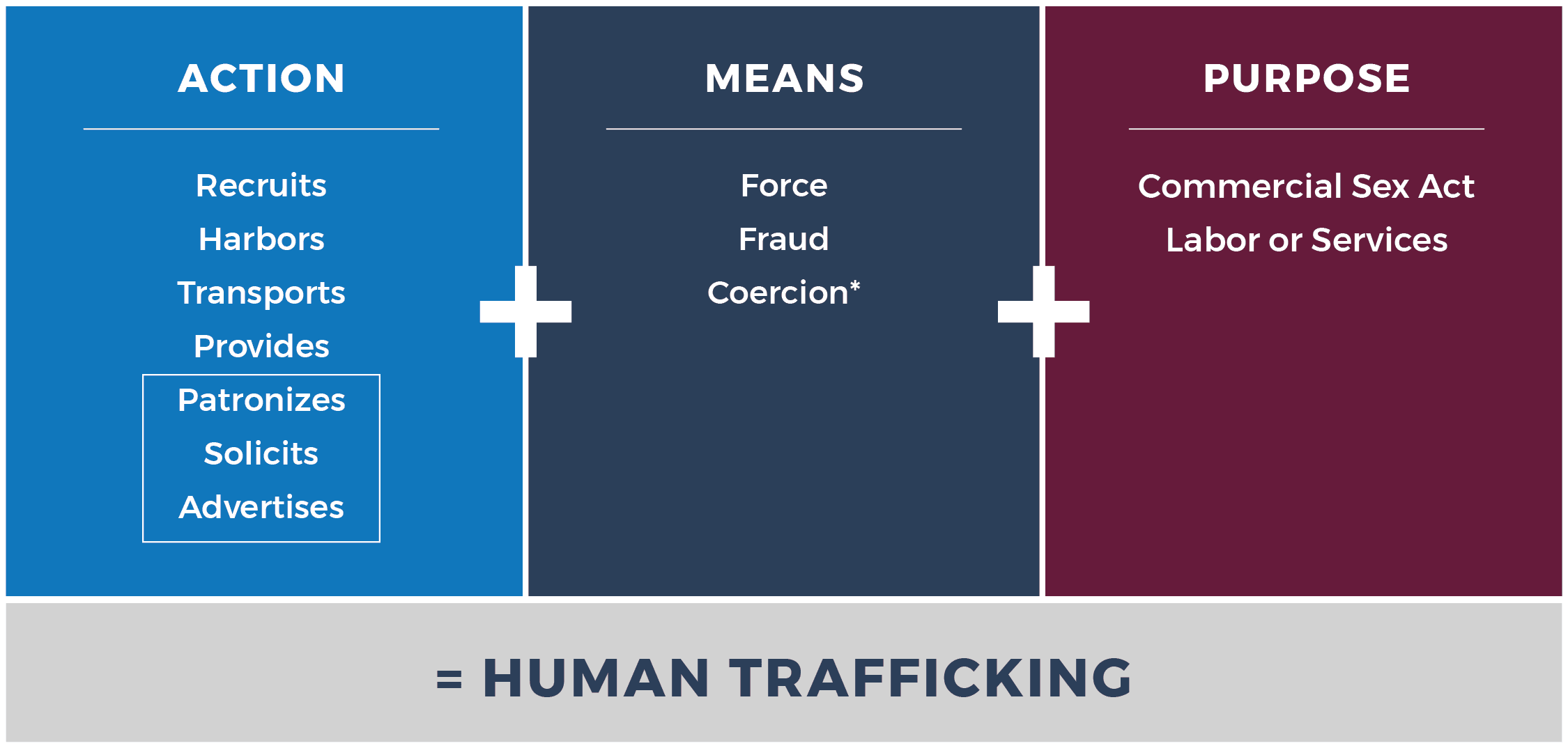
Human trafficking occurs when a perpetrator, often referred to as a trafficker, takes any one of the enumerated Actions, and then employs the Means of force, fraud or coercion for the Purpose of compelling the victim to provide commercial sex acts or labor or services. At a minimum, one element from each column must be present to establish a potential situation of human trafficking. The presence of force, fraud or coercion indicates that the victim has not consented of his or her own free will. Remember that under federal law, any minor under the age of 18 years induced into commercial sex is considered to be a victim of sex trafficking— regardless of any indicators of force, fraud, or coercion.
What are the types of Trafficking?
Sex Trafficking: a form of modern-day slavery in which individuals perform commercial sex through the use of force, fraud, or coercion.
- Victims of sex trafficking are manipulated or forced to engage in sex acts for someone else’s commercial gain.
- The National Human Trafficking Hotline provided the following statistics on sex trafficking for 2019. Note that stats are based solely on information received by the NHTH; this is not a comprehensive report on the scale or scope of human trafficking within an area.
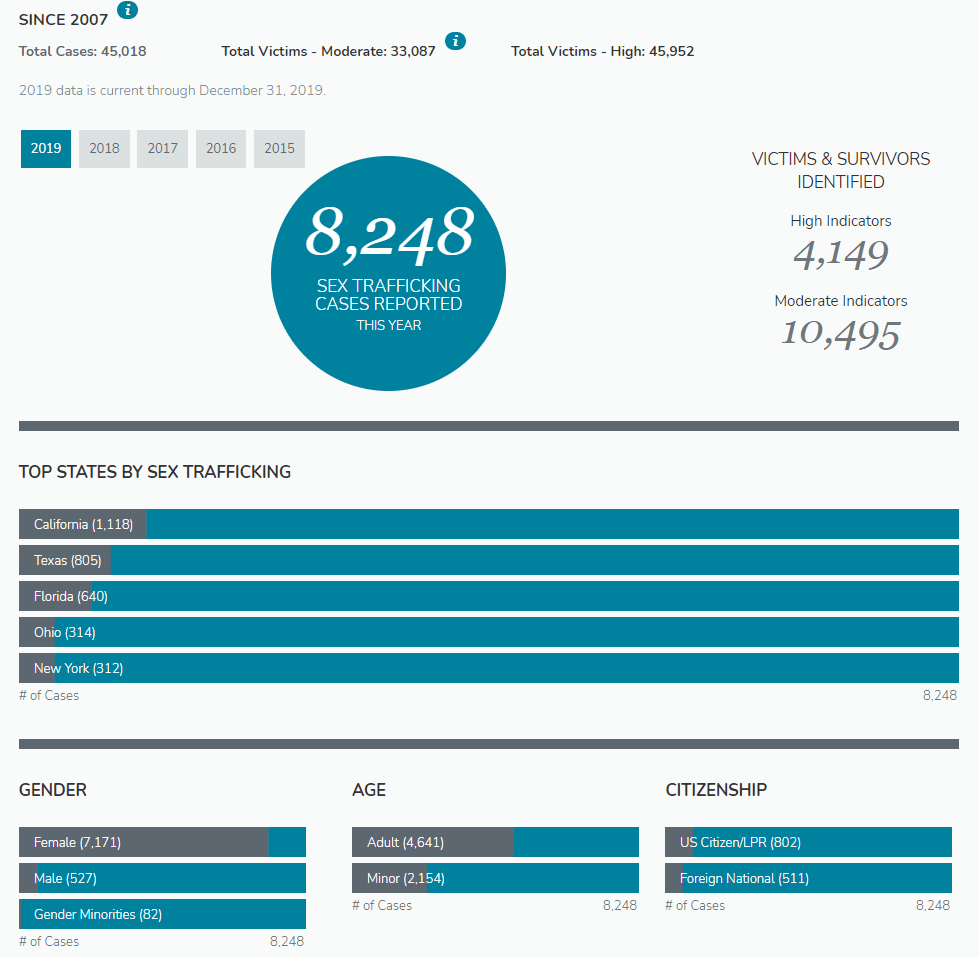
- It exists within diverse and unique set of venues and businesses including fake massage businesses, escort services, residential brothels, in public on city streets and in truck stops, strip clubs, hostess clubs, hotels and motels, and elsewhere.
- Check out the OVC’s Faces of Human Trafficking Video Series-Intro to Sex Trafficking:
Labor Trafficking: A form of modern-day slavery in which individuals perform labor or services through the use of force, fraud, or coercion.
- Situations include debt bondage, forced labor, and involuntary child labor.
- The National Human Trafficking Hotline provided the following statistics on labor trafficking for 2019. Note that stats are based solely on information received by the NHTH; this is not a comprehensive report on the scale or scope of human trafficking within an area.
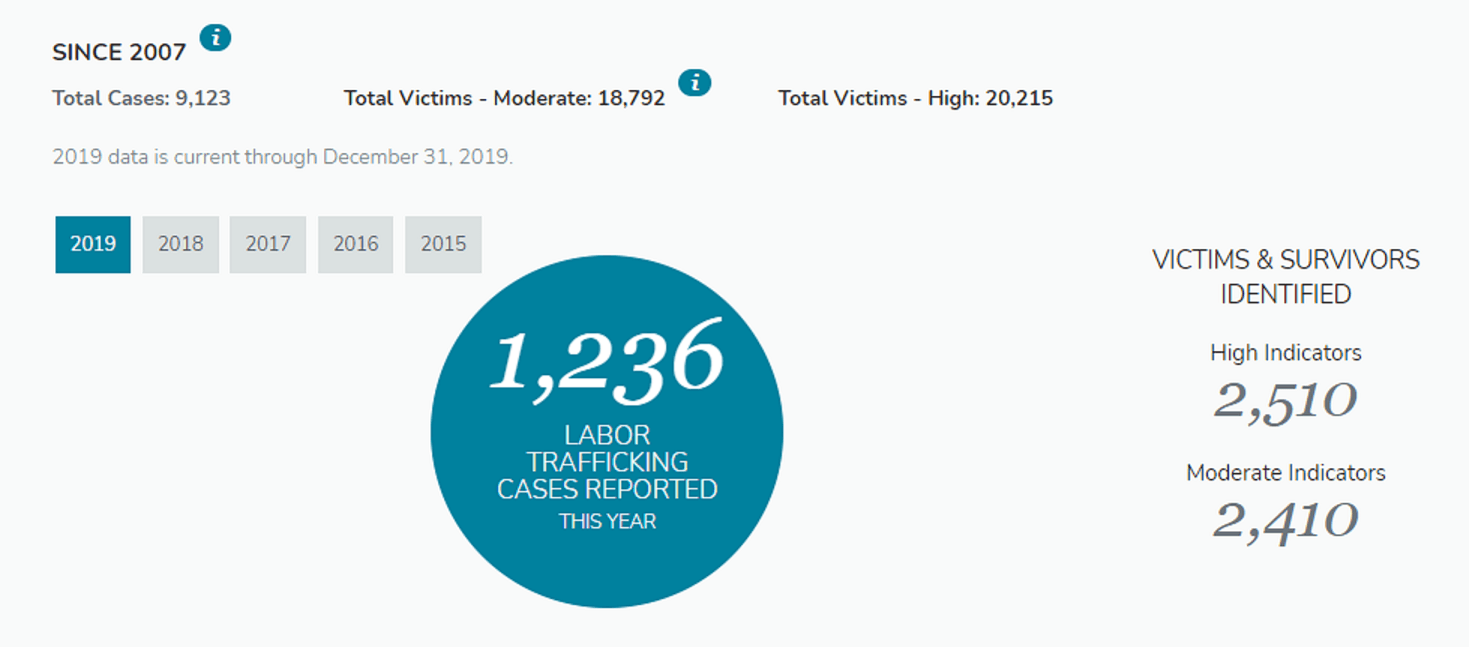
- Common types of labor trafficking include people forced to work in homes as domestic servants, farmworkers coerced through violence as they harvest crops, or factory workers held in inhumane conditions with little to no pay.
- Check out the OVC’s Faces of Human Trafficking Video Series- Intro to Labor Trafficking:
For more information, check out the Polaris Report: The Typology of Modern Slavery which segments the market of human trafficking beyond the existing categories of sex trafficking and labor trafficking, revealing 25 types of human trafficking situations in the United States. Each one has its own business model, trafficker profiles, recruitment strategies, victim profiles, and methods of control that facilitate human trafficking.
Who is vulnerable?
Human trafficking can happen to anyone but some people are more vulnerable than others. Often, traffickers identify and leverage victims’ vulnerabilities in order to create dependency. Risk factors include:
- Poverty
- Homelessness
- Substance Use
- History of sexual abuse/assault
- Child abuse/neglect (DEC)
- Runaway
- Age
- Juvenile Justice or Foster Care
- Mental health problems
- LGBTQ+
- Domestic violence
- Displaced persons (refugee/immigrant)
Who are the Traffickers?
There is no one profile of perpetrators of human trafficking. They span all racial, ethnic, gender, and socio-economic demographics. They can include individuals, business owners, members of a gang or network, parents or family members of victims, intimate partners, owners of farms or restaurants, and powerful corporate executives and government representatives.
How do Traffickers recruit their victims?
Traffickers use several recruitment tactics to lure their victims. The top recruitment tactics for sex and labor trafficking are:
- Sex trafficking: intimate partner/marriage proposition; familial; posing as a benefactor; job offer; false promises/fraud
- Labor trafficking: job offer; false promises/fraud; smuggling related; familial; posing as a benefactor
Traffickers are master manipulators who tell victims what they want to hear, and give them what they need. A trafficker will fulfill promises to earn the potential victim’s trust, love and devotion. This can happen in person, or nowadays what we are seeing is that many of the relationships between traffickers and victims are starting online.
Where do Traffickers recruit their victims?
Recruitment is occurring in several places/venues. Traffickers may systematically recruit their victims by frequenting locations where vulnerable populations congregate. Some common ones include:
- Internet
- Video Games-Chat Features
- Check out OnWatch’s Gaming Safety Guide
- Home Country
- Afterschool Programs
- Group Homes
- Homeless Shelters
- Malls
- Parks/Streets
- Libraries
- Schools
- Bus/light rail/train stations
Where does human trafficking happen?
Human Trafficking is not bound to one culture, population, or geographical area. It has been reported in all 50 states of the United States, including right here in Utah. Trafficking can occur anywhere including cities, suburb, and rural areas. The Utah map below shows where trafficking occurred in 2019. The red spots indicate higher concentrations of cases reported.
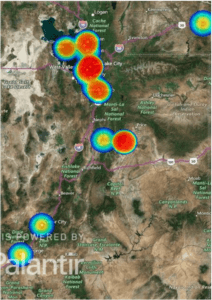
Some common venues where trafficking occurs include:
Sex Trafficking
- Online classifieds
- Pornography*
- Escort services
- Massage parlors*
- Stripping
- Streets*
- Sporting events and conventions
- Truck stops rest stops
- Hotels/motels*
- Residence based commercial sex
Labor Trafficking
- Agricultural*
- Restaurants*
- Domestic Servitude
- Forced begging
- Drug sales/couriers
- Hair and nail salons
- Construction
- Magazine/door to door sales
- Hotels/motels*
- Homes
Note: * indicates most common in Utah-based on stats from National Human Trafficking Hotline
How do Traffickers control victims?
Human trafficking involves power and control. Below is a human trafficking power and control wheel adapted from the Duluth Model by the Polaris Project that discusses common tactics used by traffickers.
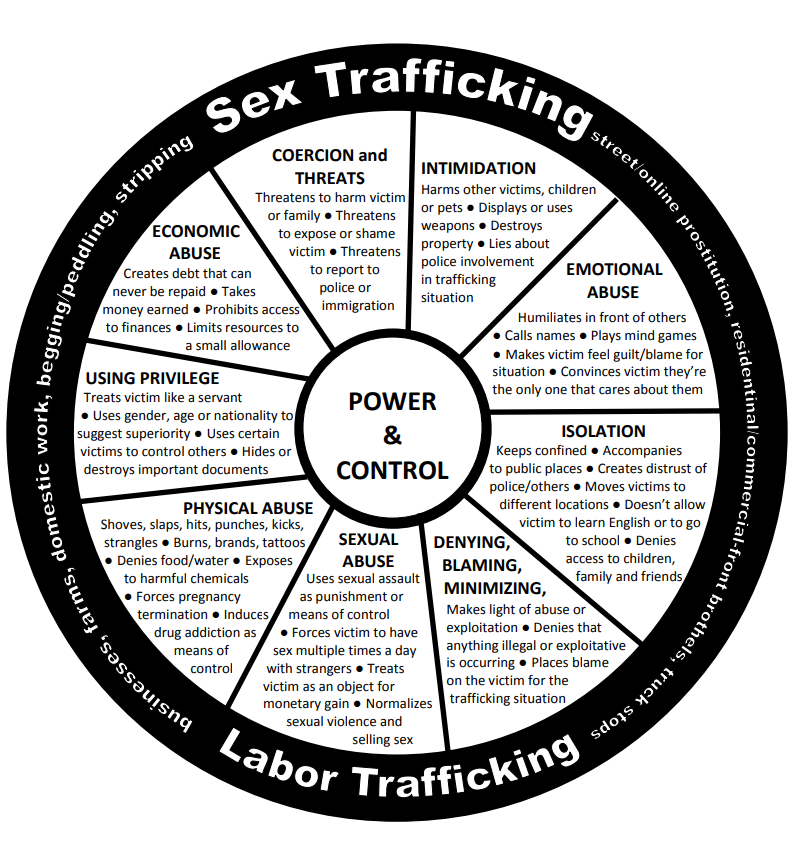
What are Barriers to Leaving a Trafficking Situation?
There are many potential barriers to leaving a trafficking situation. The following list is a sampling of reasons why trafficked persons cannot or will not leave a trafficking situation:
- Trauma bond
- Substance use disorder
- Romantically involved
- Fear of arrest and/or deportation
- Fear of loneliness
- Shame/stigma
- Economic dependency
- Loyalty
- Social support/sense of belonging/brotherhood/ sisterhood
- Distorted sense of freedom
- Belief that there is not a way out
For more information, check out this Polaris article: In Their Shoes.
Youth in Trafficking
Young people, especially those with risk factors, are vulnerable to human trafficking.
Stay tuned…additional information will be posted soon.
For more information, check out these interesting links:
- OVC’s Faces of Human Trafficking Video Series: Focus on Youth:
- DHS’ Blue Campaign: How to talk to youth about Human Trafficking
- Shared Hope International grades states on their laws related to criminalization of human trafficking of a child. Check out how Utah scores here.
- Safe House Project’s What are your kids really saying online? Article
